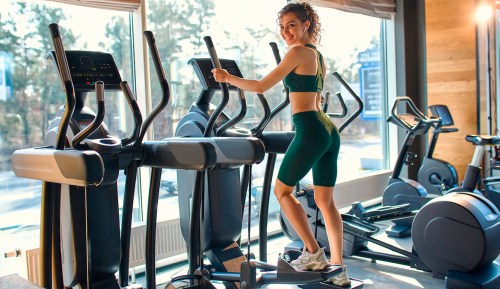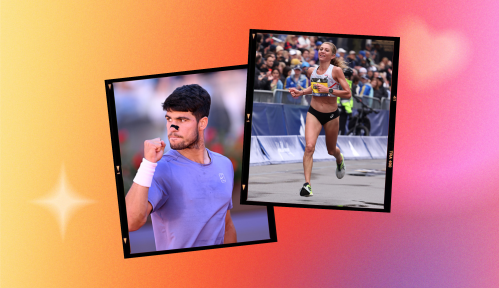Many Fitness Spaces Completely Ignore Disabled Bodies—That’s Starting To Change, But There’s Plenty of Room To Grow
Learn why adaptive fitness spaces are becoming more common, and what trainers can do to make fitness more accessible.

Whether in water or on land, low-intensity or high, moving your body is something everyone should have the opportunity to do. But all too often, fitness communities are created without ramps or room to maneuver a wheelchair, and filled with machines only designed for folks without disabilities. “At the start of my fitness journey, there were no spaces, platforms, or groups geared to helping people like me exercise,” says paraplegic athlete Zion Clark, a wrestler, Guinness World Record holder, and FitXR trainer. Without legs due to a birth defect, Clarke had trouble finding gyms that he could independently navigate around, and with equipment he could use.
Experts in This Article
Despite common misconceptions to the contrary, the disability community makes up a significant portion of the adult population. In the United states, around 61 million adults have a mobility, vision, auditory, cognitive, or self-care disability. This is more than a quarter (27 percent) of the population.
Yet few gyms or fitness studios are accessible to wheelchairs, smart canes, and other assistive devices, and few fitness professionals are prepared to build out training programs or offer appropriate modifications for exercisers with physical disabilities. This might be partially due to the fact that so many fitness spaces are founded by trainers without disabilities, and accessibility issues don’t cross their radar because those with disabilities don’t feel welcomed, so their paths never cross.
Fortunately, in just the past couple of years, there have been some legit strides made toward greater inclusivity. Proof: In 2021, the CrossFit Games finally offered a division for adaptive athletes—meaning, people with physical or neurological conditions—to compete in the sport. That same year, Peloton brought on an adaptive training consultant and released an adaptive training collection. Both Nike and Tonal now offer classes for adaptive athletes.
There are also more machines that can be used by people with disabilities than ever before. For instance, a new deadlift accessory allows individuals with one arm to deadlift. There are bikes that allow people who use wheelchairs to pedal. And we now have rowers made with visual impairments in mind.
And today, a handful of fitness studios around the country—like Split Second Fitness in New Orleans, Unified Health and Performance in Massachusetts, Iron Adaptive in Missouri, and Deaf Planet Soul in Chicago—cater specifically to the disability community.
No doubt, these examples remain the exception to the rule. “Typical gym spaces are still not functional for many people with disabilities,” says Mark Raymond Jr., founder of the non-profit Split Second Foundation and a C-5 quadriplegic. Generally speaking, the average commercial gym is not prepared to host or train people who cannot walk or cannot see, for instance.
And this oversight is doing a major disservice to those with disabilities. As adaptive CrossFit Games athlete Logan Aldridge, a Peloton instructor who teaches strength, tread, and adaptive training classes, points out, “Exercising gives people with disabilities a variety of new abilities and skills, such as being able to pick up boxes, access new ranges of motion, walk without assistance, and more.”
What’s more, the mental health benefit of exercise may be especially beneficial, says Barbara Chancey, founder of Barbara Chancey Design Group the design firm behind Texas-based CYCED, the first indoor cycling studio featuring customized bikes for “Adaptive Riders.” Indeed, research has found that people living with physical disabilities are three times more likely to experience depression. “Isolation is a growing concern [for] those with disabilities, as they are far more likely to withdraw socially,” says Chancey. “Exercise presents an opportunity to engage in group activities and the surrounding environment.”
The fact is, only when all fitness facilities are designed for wheelchair access and equipped with machines designed for people with physical disabilities, and trainer certifications require knowledge of working with clientele with disabilities, will the fitness world be truly accessible.
And as Jamal Hill, a paralympic swim medalist with Team USA points out, it’s a move that simply makes smart financial sense. “Promoting inclusivity in the fitness industry is just the right thing to do, but also it’s good for business,” he says. “By catering to the needs of a diverse range of clients, gyms and fitness centers can tap into a previously untapped market and improve their bottom line.”
So, what can fitness studios do to be more accessible?
If you’re a fitness pro and want to advocate for or make a change at your own gym, here are some expert tips:
1. Make your marketing material inclusive
The images you use in your gym marketing (including social media posts and website design) show the kind of bodies you believe belong. Ditto goes for the art you hang in your space. Make sure your photos include athletes of all abilities, says Aldridge, as well as gender presentations, sizes, and races. Better yet, hire adaptive athletes to model in your campaigns!
These images, however, should not mislead potential members. Don’t hang photographs of athletes in wheelchairs, for example, if your space is not wheelchair-accessible.
2. Put your money where your marketing is
Representation is just the start. “To be truly accessible, fitness studios must also proactively create spaces and programming that are accessible,” says Hill. This includes investing in adaptive equipment. “For example, a gym could purchase machines with adjustable seats or supports, or resistance bands that can be used from a seated position,” he says. That also includes offering classes specifically for the adaptive community, or being sure that all of your workouts can be modified to people with all different abilities, Hill says.
Ask: Who can get into the facility? Is there a ramp or are there only stairs? Similarly, who can move through the facility with ease? “It’s just coming from an empathetic perspective of, if I were in a wheelchair or couldn’t see, how would I operate in this facility?” says Aldridge. “Something as little as little lips in gym floors and little elevation changes can be pretty significant for altering the ability to navigate for a wheelchair athlete,” he explains. Accessible gyms know this and work to minimize it.
And don’t forget your restrooms, says Raymond. “The restroom facilities including lockers and shower areas need to be accessible, too,” he says. “Fixed benches in these small spaces are the worst,” he says.
To be clear, there are some accommodations that aren’t always going to be immediately obvious. Disability consultants and coordinators are experts at eying a space and outlining what needs to be updated.
3. Take stock of who you’re hiring
“Another important aspect of creating an accessible, inclusive fitness space is hiring trainers and instructors with different body types and abilities,” says Hill. This not only provides opportunities for athletes with disabilities to work in the industry, but also helps to break down stereotypes about what a “fit” body should look like, he says. The same holds true for gym staff members.
4. Offer staff accessibility trainings
“Gyms should ensure that their staff are trained in how to work with people with disabilities,” says Hill. ACE Fitness, for instance, offers a certification called Adaptive Fitness for Clients with Special Needs, while CrossFit offers an online course called Adaptive Training Academy. These courses include information like how to modify exercises, use equipment, and provide appropriate support, says Hill. Fitness studios can also provide disability inclusion training for their staff.
Remember: True accessibility includes the language we use. A coach calling themselves “OCD” when they want the room set up just so or an instructor saying it’s “lame” to modify an exercise show ableist language (and thought patterns) at work. More likely than not, it’s probably unintentional. But it’s phrases like these that can end up leaving people out.










